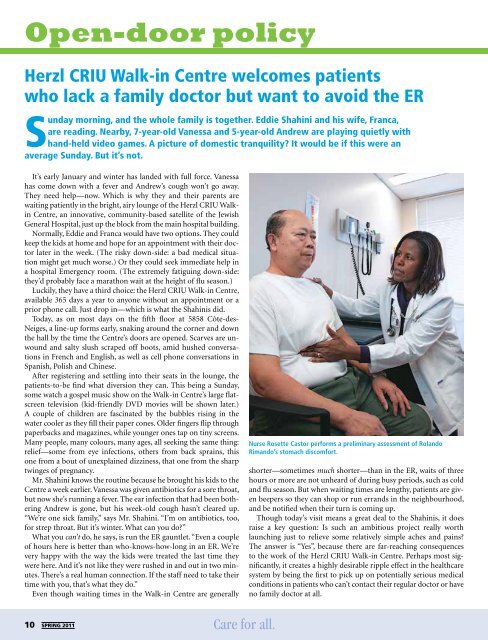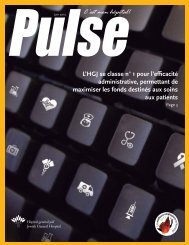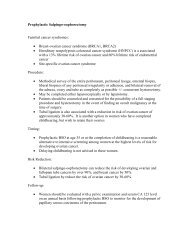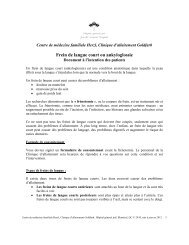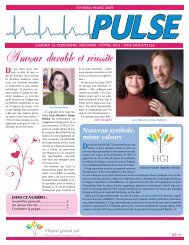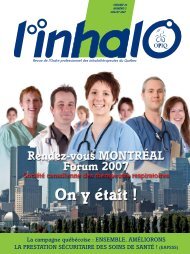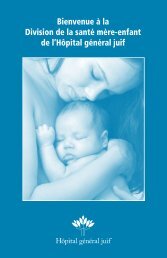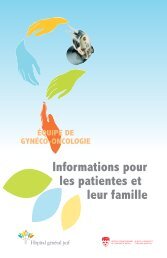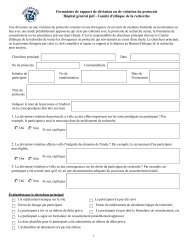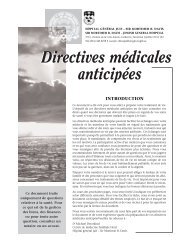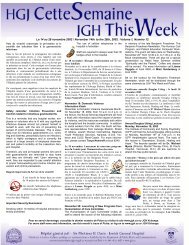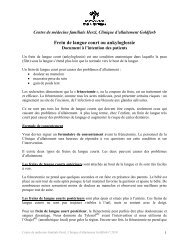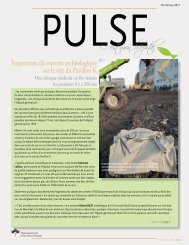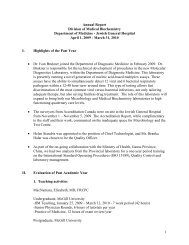No appointment? No problem!
No appointment? No problem!
No appointment? No problem!
Create successful ePaper yourself
Turn your PDF publications into a flip-book with our unique Google optimized e-Paper software.
Open-door policy<br />
Herzl CRIU Walk-in Centre welcomes patients<br />
who lack a family doctor but want to avoid the ER<br />
Sunday morning, and the whole family is together. Eddie Shahini and his wife, Franca,<br />
are reading. Nearby, 7-year-old Vanessa and 5-year-old Andrew are playing quietly with<br />
hand-held video games. A picture of domestic tranquility? It would be if this were an<br />
average Sunday. But it’s not.<br />
It’s early January and winter has landed with full force. Vanessa<br />
has come down with a fever and Andrew’s cough won’t go away.<br />
They need help—now. Which is why they and their parents are<br />
waiting patiently in the bright, airy lounge of the Herzl CRIU Walkin<br />
Centre, an innovative, community-based satellite of the Jewish<br />
General Hospital, just up the block from the main hospital building.<br />
<strong>No</strong>rmally, Eddie and Franca would have two options. They could<br />
keep the kids at home and hope for an <strong>appointment</strong> with their doctor<br />
later in the week. (The risky down-side: a bad medical situation<br />
might get much worse.) Or they could seek immediate help in<br />
a hospital Emergency room. (The extremely fatiguing down-side:<br />
they’d probably face a marathon wait at the height of flu season.)<br />
Luckily, they have a third choice: the Herzl CRIU Walk-in Centre,<br />
available 365 days a year to anyone without an <strong>appointment</strong> or a<br />
prior phone call. Just drop in—which is what the Shahinis did.<br />
Today, as on most days on the fifth floor at 5858 Côte-des-<br />
Neiges, a line-up forms early, snaking around the corner and down<br />
the hall by the time the Centre’s doors are opened. Scarves are unwound<br />
and salty slush scraped off boots, amid hushed conversations<br />
in French and English, as well as cell phone conversations in<br />
Spanish, Polish and Chinese.<br />
After registering and settling into their seats in the lounge, the<br />
patients-to-be find what diversion they can. This being a Sunday,<br />
some watch a gospel music show on the Walk-in Centre’s large flatscreen<br />
television (kid-friendly DVD movies will be shown later.)<br />
A couple of children are fascinated by the bubbles rising in the<br />
water cooler as they fill their paper cones. Older fingers flip through<br />
paperbacks and magazines, while younger ones tap on tiny screens.<br />
Many people, many colours, many ages, all seeking the same thing:<br />
relief—some from eye infections, others from back sprains, this<br />
one from a bout of unexplained dizziness, that one from the sharp<br />
twinges of pregnancy.<br />
Mr. Shahini knows the routine because he brought his kids to the<br />
Centre a week earlier. Vanessa was given antibiotics for a sore throat,<br />
but now she’s running a fever. The ear infection that had been bothering<br />
Andrew is gone, but his week-old cough hasn’t cleared up.<br />
“We’re one sick family,” says Mr. Shahini. “I’m on antibiotics, too,<br />
for strep throat. But it’s winter. What can you do?”<br />
What you can’t do, he says, is run the ER gauntlet. “Even a couple<br />
of hours here is better than who-knows-how-long in an ER. We’re<br />
very happy with the way the kids were treated the last time they<br />
were here. And it’s not like they were rushed in and out in two minutes.<br />
There’s a real human connection. If the staff need to take their<br />
time with you, that’s what they do.”<br />
Even though waiting times in the Walk-in Centre are generally<br />
10 spriNG 2011<br />
Care for all.<br />
Nurse Rosette Castor performs a preliminary assessment of Rolando<br />
Rimando’s stomach discomfort.<br />
shorter—sometimes much shorter—than in the ER, waits of three<br />
hours or more are not unheard of during busy periods, such as cold<br />
and flu season. But when waiting times are lengthy, patients are given<br />
beepers so they can shop or run errands in the neighbourhood,<br />
and be notified when their turn is coming up.<br />
Though today’s visit means a great deal to the Shahinis, it does<br />
raise a key question: Is such an ambitious project really worth<br />
launching just to relieve some relatively simple aches and pains?<br />
The answer is “Yes”, because there are far-reaching consequences<br />
to the work of the Herzl CRIU Walk-in Centre. Perhaps most significantly,<br />
it creates a highly desirable ripple effect in the healthcare<br />
system by being the first to pick up on potentially serious medical<br />
conditions in patients who can’t contact their regular doctor or have<br />
no family doctor at all.


